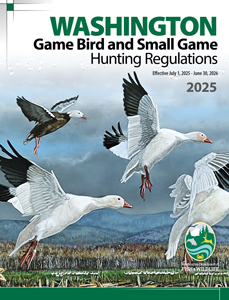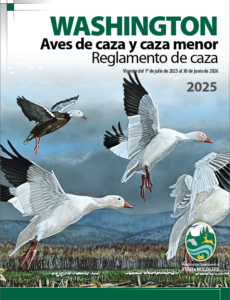Summary of Federal Regulations
Below is a summary of the most commonly violated federal regulations. Federal regulations related to migratory bird hunting are located in Title 50, Code of Federal Regulations, Part 20.
For a complete list of federal regulations pertaining to migratory bird hunting, prior to going afield hunters should visit the U.S. Fish and Wildlife Service website.
No persons shall take migratory game birds:
- With a trap, snare, net, rifle, pistol, swivel gun, shotgun larger than 10 gauge, punt gun, battery gun, machine gun, fish hook, poison, drug, explosive, or stupefying substance.
- With a shotgun of any description capable of holding more than three shells, unless it is plugged with a one-piece filler, incapable of removal without disassembling the gun, so its total capacity does not exceed three shells.
- From or by means, aid, or use of a sinkbox or any other type of low floating device, having a depression affording the hunter a means of concealment beneath the surface of the water.
- From or by means, aid, or use of any motor vehicle, motor-driven land conveyance, or aircraft of any kind, except that paraplegics and persons missing one or both legs may take from any stationary motor vehicle or stationary motor-driven land conveyance.
- From or by means of any motorboat or other craft having a motor attached, or any sailboat, unless the motor has been completely shut off and/or the sails furled, and its progress therefrom has ceased: Provided, that a craft under power may be used to retrieve dead or crippled birds; however, crippled birds may not be shot from such craft under power.
- By the use or aid of live birds as decoys; although not limited to, it shall be a violation of this paragraph for any person to take migratory waterfowl on an area where tame or captive live ducks or geese are present unless such birds are and have been for a period of 10 consecutive days prior to such taking, confined within an enclosure which substantially reduces the audibility of their calls and totally conceals such birds from the sight of wild migratory waterfowl.
- By the use or aid of recorded or electrically amplified bird calls or sounds, or recorded or electrically amplified imitations of bird calls or sounds.
- By means or aid of any motor driven land, water, or air conveyance, or any sailboat used for the purpose of or resulting in the concentrating, driving, rallying, or stirring up of any migratory bird.
- By the aid of baiting, or on or over any baited area, where a person knows or reasonably should know that the area is or has been baited. However, nothing in this paragraph prohibits:
- The taking of any migratory game bird, including waterfowl, coots, and cranes, on or over the following lands or areas that are not otherwise baited areas:
- Standing crops or flooded standing crops (including aquatics); standing, flooded, or manipulated natural vegetation; flooded harvested croplands; or lands or areas where seeds or grains have been scattered solely as the result of a normal agricultural planting, harvesting, post-harvest manipulation or normal soil stabilization practice.
- From a blind or other place of concealment camouflaged with natural vegetation.
- From a blind or other place of concealment camouflaged with vegetation from agricultural crops, as long as such camouflaging does not result in the exposing, depositing, distributing or scattering of grain or other feed.
- Standing or flooded standing agricultural crops where grain is inadvertently scattered solely as a result of a hunter entering or exiting a hunting area, placing decoys, or retrieving downed birds.
- The taking of any migratory game bird, except waterfowl, coots and cranes, on or over lands or areas that are not otherwise baited areas, and where grain or other feed has been distributed or scattered solely as the result of manipulation of an agricultural crop or other feed on the land where grown, or solely as the result of a normal agricultural operation.
- The taking of any migratory game bird, including waterfowl, coots, and cranes, on or over the following lands or areas that are not otherwise baited areas:
Personal abode:
One's principal or ordinary home or dwelling place, as distinguished from one's temporary or transient place of abode or dwelling such as a hunting club, or any club house, cabin, tent or trailer house used as a hunting club, or any hotel, motel or rooming house used during a hunting, pleasure or business trip
Wanton waste of migratory game birds:
No person shall kill or cripple any migratory game bird without making a reasonable effort to retrieve the bird, and retain it in his actual custody, at the place where taken or between that place and either:
- His automobile or principal means of land transportation; or
- His personal abode or temporary or transient place of lodging; or
- A migratory bird preservation facility; or
- A post office; or
- A common carrier facility.
Possession:
Possession Limit:
The maximum number of migratory game birds of a single species or a combination of species permitted to be possessed by any one person when lawfully taken in the United States in any one specified geographic area for which a possession limit is prescribed.
Field possession limit:
No person shall possess, have in custody, or transport more than the daily bag limit or aggregate daily bag limit, whichever applies, of migratory game birds, tagged or not tagged, at or between the place where taken and either:
- His automobile or principal means of land transportation; or
- His personal abode or temporary or transient place of lodging; or
- A migratory bird preservation facility; or
- A post office; or
- A common carrier facility.
Possession tagging requirement:
No person shall put or leave any migratory game birds at any place (other than at his personal abode), or in the custody of another person for picking, cleaning, processing, shipping, transportation, or storage (including temporary storage), or for the purpose of having taxidermy services performed, unless such birds have a tag attached, signed by the hunter, stating his address, the total number and species of birds, and the date such birds were killed.
Migratory game birds being transported in any vehicle as the personal baggage of the possessor shall not be considered as being in storage or temporary storage.
Custody of birds of another:
No person shall receive or have in custody any migratory game birds belonging to another person unless such birds are tagged as required above.
Termination of possession:
The possession of birds taken by any hunter shall be deemed to have ceased when such birds have been delivered by him to another person as a gift; or have been delivered by him to a post office, a common carrier, or a migratory bird preservation facility and consigned for transport by the Postal Service or a common carrier to some person other than the hunter.
Gift of migratory game birds:
No person may receive, possess, or give to another, any freshly killed migratory game birds as a gift, except at the personal abodes of the donor or donee, unless such birds have a tag attached, signed by the hunter who took the birds, stating such hunter's address, the total number and species of birds and the date such birds were taken.
Transportation of birds for another:
No person shall transport migratory game birds belonging to another person unless such birds are tagged as required above.
Species identification requirement:
No person shall transport within the United States any migratory game birds, except doves and band-tailed pigeons (Columba fasciata), unless the head or one fully feathered wing remains attached to each such bird at all times while being transported from the place where taken until they have arrived at the personal abode of the possessor or a migratory bird preservation facility.
Migratory bird preservation facilities:
Tagging requirement:
No migratory bird preservation facility shall receive or have in custody any migratory game birds unless such birds are tagged.
Records required:
- No migratory bird preservation facility shall:
- Receive or have in custody any migratory game bird unless accurate records are maintained which can identify each bird received by, or in the custody of, the facility by the name of the person from whom the bird was obtained, and show (i) the number of each species; (ii) the location where taken; (iii) the date such birds were received; (iv) the name and address of the person from whom such birds were received; (v) the date such birds were disposed of; and (vi) the name and address of the person to whom such birds were delivered, or
- Destroy any records required to be maintained for a period of 1-year following the last entry on the record.
- Record keeping as required by this section will not be necessary at hunting clubs which do not fully process migratory birds by removal of both the head and wings.
Inspection of premises:
No migratory bird preservation facility shall prevent any person authorized to enforce this part from entering such facilities at all reasonable hours and inspecting the records and the premises where such operations are being carried.
Federal Migratory Bird Band Reporting
To report bird band recoveries and contribute to migratory bird research, please visit the U.S. Geological Survey's Report Band website.
You will need to provide the band number and how, when and where it was recovered. You will receive a certificate of appreciation via email, about the bird.
The band is yours to keep.


